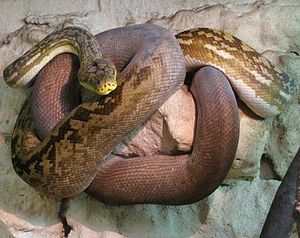Malayopython
| Malayopython | ||||||||||||
|---|---|---|---|---|---|---|---|---|---|---|---|---|

Timorpython ( Malayopython timoriensis ) |
||||||||||||
| Systematics | ||||||||||||
|
||||||||||||
| Scientific name | ||||||||||||
| Malayopython | ||||||||||||
| Reynolds , Niemiller & Revell , 2014 |
Malayopython is a genus of snakes from the family of pythons (Pythonidae). The two associated species, the reticulated python ( Malayopython reticulatus ) and the Timorpython ( Malayopython timoriensis ), occur in Southeast Asia .
features
The giant snakes of the genus Malayopython reach a body length of up to 10 meters. They resemble the snakes from the genus of the actual pythons ( Python ). The following features distinguish them from them: The labial pits , with which they can perceive heat, are on the lower lip at the level of the eyes and on the upper lip at the front of the head. The labial pits are more pronounced on the lower lip than or at least similarly strong as those on the upper lip. With the actual pythons it is the other way round: The labial pits on the lower lip are significantly smaller than those on the upper lip. While the actual pythons have a dark spot around the labial pits of the lower lip, the labial pits of Malayopython are colored just like the rest of the lower lip. There are also differences in the development of the wing bone and the hemipenes .
Systematics
The reticulated python and the Timorpython originally belonged to the genus of the real pythons ( Python ), which occurs in Africa, South Asia and Southeast Asia. Phylogenetic studies showed, however, that the two species are more closely related to the python genera from eastern Indonesia, New Guinea and Australia than to the other species of the real pythons. In 2004, Broghammerus was introduced by Hoser as the name of a new genus for the reticulated python. In this work, Hoser introduced a number of new species and genera without providing the necessary scientific basis for a regrouping. Accordingly, subsequent authors have not accepted these changes. However, the reticulated python and the Timor python were used by Rawlings et al. In 2008 placed in the newly created genus Broghammerus . The generic name Broghammerus was placed in a journal that does not carry out a peer review process. As a replacement for this name, which is generally regarded as invalid, the generic name Malayopython for reticulated python and Timorpython was introduced at the beginning of 2014 .
The following cladogram shows the internal systematics of the pythons and the position of the Malayopython as a sister group of the Australasian pythons:
| Pythonidae |
|
||||||||||||||||||||||||||||||||||||||||||
|
|
The type species of the genus is Malayopython reticulatus .
Distribution area
The distribution area of the genus Malayopython is in Southeast Asia. Of the two species of the genus, the reticulated python has the larger distribution area: Starting in the northeast in Bangladesh, it covers large parts of Southeast Asia and extends in the west to Indonesia. The Timorpython probably only occurs in the Lesser Sunda Islands east of Java. In contrast to this, the real pythons ( Python ) also include the species of the python family (Pythonidae) that occur in Africa, in addition to species that are also common in Southeast Asia. The remaining genera of the family are common in Australia and Papua New Guinea.
Way of life
Little is known about the way of life. Like the real pythons, the two species of the genus Malayopython are nocturnal. They mainly hunt mammals and birds. Like all pythons, they are non-toxic and kill their prey by entangling them.
Individual evidence
- ^ A b Lesley H. Rawlings, Daniel L. Rabosky, Stephen C. Donnellan, Mark N. Hutchinson: Python phylogenetics: inference from morphology and mitochondrial DNA . In: Biological Journal of the Linnean Society . tape 93 , 2008, p. 603-619 .
- ↑ Hinrich Kaiser, Brian I. Crother, Christopher MR Kelly, Luca Luiselli, Mark O´Shea, Hidetoshi Ota, Paulo Passos, Wulf D. Schleip, Wolfgang Wüster: Best Practices: In the 21st Century, Taxonomic Decisions in Herpetology are Acceptable Only When Supported by a Body of Evidence and Published via Peer Review . In: Herpetological Review, 2013, 44 (1), 8-23. tape 44 , 2013, p. 8-23 .
- ^ A b c R. Graham Reynolds, Matthew L. Niemiller, Liam J. Revell: Toward a Tree-of-Life for the boas and pythons: Multilocus species-level phylogeny with unprecedented taxon sampling. Molecular Phylogenetics and Evolution, Volume 71, February 2014, Pages 201-213, doi: 10.1016 / j.ympev.2013.11.011
- ↑ Malayopython reticulatus in The Reptile Database
- ↑ Malayopython timoriensis in The Reptile Database
